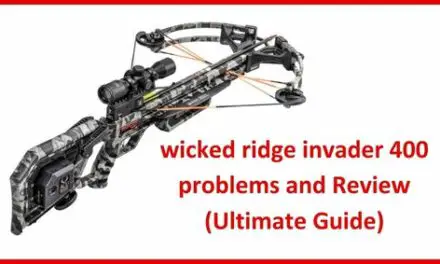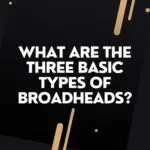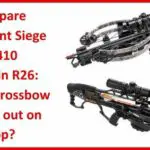You are here to know: what are the three basic types of broadheads?
Well, the three basic types of broadheads are fixed blades, removable blades, and mechanical (expandable) blades.
Fixed blade broadheads are designed to glue directly onto the arrow shaft or have a screw-in design.
Removable blade broadheads are designed so that the blades can be replaced on the ferrule.
Mechanical or expandable blade broadheads have blades that are retracted close to the ferrule before the shot and expand upon impact to expose the cutting edges
Let’s compare each in detail.
What Are The Three Basic Types Of Broadheads?
The three basic types of broadheads are fixed blade, removable blade, and mechanical (expandable) blade.
Each type has its own characteristics and is suited for different hunting situations.
Fixed blade broadheads have two or more blades that need to be manually sharpened, while removable blade broadheads have pre-sharpened blades that can be replaced after the shot.
Mechanical broadheads have blades that are folded into the head and expand upon impact, cutting a larger area than fixed blade broadheads

Comparison
Here is a detailed comparison of the three main types of broadheads:
| Feature | Fixed Blade | Removable Blade | Mechanical (Expandable) |
| Blade Design | Single, fixed blade | Multiple replaceable blades | Blades retract into ferrule until impact |
| Durability | Very durable | Less durable than fixed blade | More susceptible to damage than other types |
| Sharpening | Easy to sharpen | Requires removing and replacing blades | Can be difficult to sharpen |
| Flight Characteristics | May require tuning due to different flight profile than field tips | Flies like a field tip | Flies like a field tip |
| Penetration | Excellent penetration | Good penetration | Less penetration due to energy loss opening blades |
| Cutting Diameter | Small cutting diameter | Large cutting diameter | Very large cutting diameter |
| Cost | Relatively inexpensive | More expensive than fixed blade | Most expensive type of broadhead |
| Recommended Draw Weight | Any draw weight | Any draw weight | Typically requires 50+ pounds draw weight |
| Best for | Traditional archers, low draw weight bows, heavy bone shots | Target practice, ethical hunting, replaceable blades | High-speed bows, long-distance shots, large game |
Choosing the Right Broadhead:
The best type of broadhead for you will depend on your individual needs and preferences.
Consider factors such as the type of bow you use, the game you are hunting, your budget, and your shooting style when making your decision.
Fixed Blade Broadheads
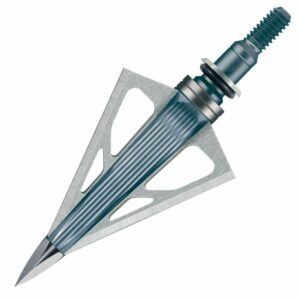
Fixed blade broadheads are a classic and reliable choice for archers of all levels.
They offer a number of advantages over other types of broadheads, making them a popular option for many hunters.
Here is a comprehensive overview of fixed blade broadheads:
Design and Construction:
- A fixed blade broadhead consists of a single, sharp blade that is permanently attached to a ferrule (the metal part that screws onto the arrow shaft).
- The blade is typically made from high-quality stainless steel or carbon steel, ensuring durability and excellent cutting performance.
- Fixed blade broadheads come in a variety of sizes and styles, with different blade shapes and cutting diameters.
Advantages:
- Durable and reliable: Fixed blade broadheads are built to last and can withstand a lot of abuse. They are less susceptible to damage than other types of broadheads, such as mechanical or expandable broadheads.
- Excellent penetration: The simple design of a fixed blade broadhead allows it to penetrate deep into the target, even through bone and heavy muscle. This is crucial for ethically taking down game.
- Easy to sharpen: You can easily sharpen a fixed blade broadhead in the field with a whetstone or diamond sharpener. This allows you to keep your broadheads in top condition, even on extended hunting trips.
- Affordable: Fixed blade broadheads are typically the most affordable option compared to other types of broadheads. This makes them a good choice for budget-conscious hunters.
- Proven effectiveness: Fixed blade broadheads have been used for centuries and have a long history of success in the field. They are a reliable choice for hunters who want to ensure a clean and ethical kill.
Disadvantages:
- May require tuning: Fixed blade broadheads fly differently than field tips, so you may need to tune your bow to ensure they fly accurately. This can be a time-consuming process, especially for new archers.
- Can be difficult to remove from target: The large cutting diameter of a fixed blade broadhead can make it difficult to remove from the target. This can be a problem if you are hunting in thick brush or difficult terrain.
Best Uses:
- Fixed blade broadheads are a good choice for hunters who:
- Use traditional bows or low-draw weight bows.
- Are hunting large game with heavy bones.
- Want a durable and reliable broadhead that is easy to maintain.
- Are on a budget.
Popular Fixed Blade Broadhead Brands:
- NAP: Thunderhead, Hellrazor
- New Archery Products: Exodus, Spitfire
- Muzzy: MX-4, Trocar
- Swhacker: Hammer
- Wasp: Jak Hammer, Drone
Removable Blade Broadheads

Removable blade broadheads offer a unique combination of convenience and performance, making them a popular choice for many archers.
Here’s a comprehensive analysis of their pros and cons:
Design and Construction:
- Removable blade broadheads feature replaceable blades that are attached to the ferrule (metal part of the broadhead) using screws or other mechanisms.
- This allows you to replace damaged or dull blades quickly and easily, without having to discard the entire broadhead.
- Removable blades come in various materials, like stainless steel, carbon steel, and even ceramic, offering different levels of durability and sharpness.
Advantages:
- Convenience: Replacing blades is significantly easier than sharpening or buying new broadheads, saving time and resources.
- Versatility: You can use different blade configurations based on your hunting needs. For example, you can use a three-blade configuration for improved penetration or a four-blade configuration for increased cutting diameter.
- Reduced maintenance: Removing and replacing blades allows for easier cleaning and inspection, ensuring optimal performance.
- Ethical hunting: The ability to quickly replace dull blades increases the chance of a clean and ethical kill.
- Target practice: You can use the same broadhead for target practice and hunting, eliminating the need for separate broadheads.
Disadvantages:
- Higher cost: Removable blade broadheads are typically more expensive than fixed-blade broadheads, although replacement blades can be purchased separately.
- Durability limitations: The blades can be susceptible to damage from bone or other hard objects, requiring more frequent replacements.
- Sharpening difficulties: While some blades are replaceable, sharpening existing blades can be more challenging than sharpening fixed-blade broadheads.
- Potential blade loss: There’s a slight risk of blades loosening or falling out during flight, impacting accuracy.
Best Uses:
- Removable blade broadheads are ideal for:
- Hunters who want the convenience of replaceable blades.
- Archers who practice regularly and desire a single broadhead for both target practice and hunting.
- Hunters who prefer different blade configurations for various hunting situations.
- Ethical hunters who prioritize clean kills.
Popular Removable Blade Broadhead Brands:
- NAP: Bloodrunner, SpitFire
- New Archery Products: Exodus, Spitfire
- G5 Outdoors: Striker V2, Montec M3
- Grim Reaper: Hades Pro, Broadhead
- Slick Trick: Standard, Magnum
- RAGE VS GRIM REAPER BROADHEAD
Mechanical Broadheads
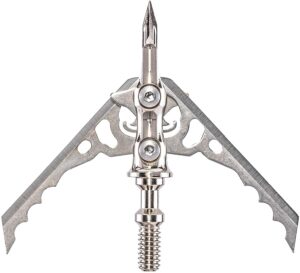
Mechanical broadheads, also known as expandable broadheads, have revolutionized the archery world with their innovative design and impressive performance.
Let’s explore the ins and outs of these advanced broadheads:
Design and Function:
- Mechanical broadheads feature blades that remain closed within the ferrule until impact. Upon contact with the target, the blades deploy outward, creating a large cutting diameter.
- This unique design provides several advantages, including increased accuracy during flight (due to the streamlined ferrule) and exceptional cutting potential once deployed.
- Various blade configurations exist, offering different cutting diameters and wound channels for diverse hunting scenarios.
Advantages:
- Superior accuracy: The streamlined ferrule ensures consistent flight performance, mimicking the trajectory of field tips.
- High cutting diameter: Once deployed, the blades expand, creating a massive wound channel for swift blood trails and faster kills.
- Ideal for high-speed bows: Mechanical broadheads handle the increased force generated by high-speed bows efficiently, minimizing blade failure.
- Reduced wind drift: The compact design minimizes wind drift compared to fixed-blade broadheads, enhancing accuracy at longer distances.
- Multiple configurations: Choose between different blade configurations to match your specific hunting needs and target species.
Disadvantages:
- Higher cost: Mechanical broadheads are generally more expensive than fixed-blade or replaceable-blade options.
- Potential for failure: Moving parts can malfunction in extreme conditions or upon hitting bone, compromising performance.
- Durability concerns: The intricate mechanisms are more susceptible to damage compared to simpler fixed-blade designs.
- Sharpening challenges: Sharpening the smaller, often curved blades can be more difficult than sharpening fixed blades.
- Minimum draw weight requirement: Most mechanical broadheads require a minimum draw weight of 50 pounds to function properly.
Best Uses:
- Mechanical broadheads excel in situations like:
- Hunting large game with heavy muscles and bones.
- Using high-speed bows that require broadheads to handle significant impact forces.
- Prioritizing maximum blood trails for easier tracking and retrieval.
- Shooting at longer distances where accuracy is paramount.
- Targeting multiple species with varying blade configurations.
Popular Mechanical Broadhead Brands:
- NAP: SpitFire Maxx, ShockWave
- Swhacker: Hammer, Grim Reaper
- Rage: Hypodermic, Trypan
- G5 Outdoors: DeadMeat, Montec CS
- Grim Reaper: Razortip Chisel, Fatal Steel
Choosing the right broadhead
Choosing the right broadhead is crucial for a successful and ethical hunt. Here’s how to navigate the options and select the best one for your needs:
Consider Your Bow and Draw Weight:
- Match the broadhead weight to your bow’s draw weight: Improper weight can lead to inaccurate shots and decreased penetration.
- Check minimum draw weight requirements: Some broadheads, like mechanical, require a minimum draw weight to function properly.
Analyze Your Target Species:
- Game size and bone structure: Larger animals and those with thick bone require broadheads with excellent penetration and a large cutting diameter.
- Desired wound channel size: Broadheads with larger cutting diameters create larger wounds for faster blood trails and easier tracking.
Evaluate Your Hunting Style:
- Shooting distance: Broadhead accuracy becomes crucial at longer distances. Consider mechanical broadheads for their streamlined design and minimal wind drift.
- Hunting environment: Dense terrain may make broadhead removal challenging. Choose fixed blades for their ease of removal or mechanical broadheads for their streamlined design.
Broadhead Features to Analyze:
- Blade type: Fixed blades offer simplicity and durability, while removable blades provide versatility and convenience. Mechanical broadheads excel in accuracy and cutting diameter.
- Material: High-quality materials like stainless steel or carbon steel ensure optimal performance and durability.
- Sharpness: Ensure your broadheads are razor-sharp for ethical and effective hunting. Consider sharpening tools and ease of maintenance.
- Cost: Choose a broadhead that fits your budget while offering the desired features and performance.
Research and Compare:
- Read reviews and compare features of different broadheads.
- Consult with experienced hunters or archery experts for recommendations.
- Test different broadheads at the archery range to assess accuracy and flight characteristics.
Additional Tips:
- Use field points that match the weight and flight characteristics of your broadhead for accurate shooting.
- Always practice with your chosen broadhead before hunting to ensure proficiency and confidence.
- Consider ethical hunting practices when choosing your broadhead.
- Never use a dull broadhead, as it can lead to unethical and inhumane kills.
By following these steps and carefully considering your individual needs and preferences, you can choose the right broadhead for a successful and ethical hunt.
Remember, the best broadhead is the one that performs consistently and ethically under your specific hunting conditions.
Frequently Asked Questions
What are the main differences between fixed blade, removable blade, and mechanical broadheads?
The main differences lie in the blade design and deployment mechanism:
- Fixed Blade: Single, fixed blade provides excellent penetration and durability.
- Removable Blade: Multiple replaceable blades offer versatility and convenience.
- Mechanical Blades retract in flight and deploy on impact, maximizing accuracy and cutting diameter.
Which broadhead is the most accurate?
Mechanical broadheads typically fly like field tips due to their streamlined design, making them highly accurate, especially at longer distances.
Which broadhead provides the best penetration?
Fixed blades excel in penetration due to their simple design and minimal energy loss. They are ideal for hunting large game with heavy bones.
Which broadhead is most suitable for target practice?
Removable blades are convenient for target practice and hunting without needing to sharpen the same blades repeatedly.
Which broadhead is the easiest to maintain?
Fixed blades are the easiest to maintain, requiring only basic sharpening tools. Mechanical broadheads are more complex and susceptible to damage.
Which broadhead is the most ethical for hunting?
Both mechanical and removable blade broadheads offer large cutting diameters, leading to faster kills and potentially more ethical hunting practices.
Which broadhead is the most expensive?
Mechanical broadheads are generally the most expensive due to their complex mechanisms and intricate blades.
Which broadhead is best for high-speed bows?
Mechanical broadheads are specifically designed to handle the increased impact force generated by high-speed bows.
What factors should I consider when choosing a broadhead?
Consider your bow’s draw weight, target species, hunting style, desired accuracy and penetration, budget, and ethical considerations.
How can I ensure my broadheads are sharp?
Invest in high-quality sharpening tools and regularly sharpen your broadheads before hunting. Dull broadheads can lead to unethical and inhumane kills.
Conclusion
Broadheads are used for hunting big game and can be divided into three basic types: fixed blades, removable blades, and mechanical (expandable) blades.
Fixed blade broadheads are designed to glue directly onto the arrow shaft or have a screw-in design that fits most screw-in type ferrules and can be used with adapters.
Removable blade broadheads are designed so that the blades can be replaced on the ferrule, and there is no need to discard the entire broadhead if only the blades are damaged.
Mechanical or expandable blade broadheads have blades that are retracted close to the ferrule before the shot and expand upon impact to expose the cutting edges.
These blades are recommended for use only with bows rated 50 pounds or more because most mechanical blades require a certain amount of kinetic energy to open properly.
Fixed blade broadheads are more durable and reliable than mechanical broadheads, but mechanical broadheads offer better accuracy and penetration.
Removable blade broadheads offer the convenience of replacing only the blades that are damaged, but they may not be as durable as fixed blade broadheads.





